Dean &
Ginny's excellent adventures, a series of
|
|
|
When the weekly run from Charleston to Honduras came up, we decided to go there instead. The show time for the flight wavered from 3:45am to 6am, so we spent the night in the Charleston terminal. It left shortly after 6. Two and a half hours later we landed on the Enrique Soto Cano Airfield located in the center of the country near Comayagua. (Here is a link to a good map of Honduras: www.lib.utexas.edu/maps/americas/honduras.jpg) We
talked to an old, retired guy in the terminal while we waited for our
luggage. He gave us his Honduras travel guide and lots of advice—he's a diver and this was his fifth trip to the
country.
On his advice and others, we decided that we'd take the express bus
to the coast so we could really see the country. (We were
warned not to take the "chicken bus" which makes many stops and
people actually carry their produce and chickens to market on these local
buses.) Before we could get started, we needed
some lempiras, Honduras currency—18.9 lempira/dollar. While we waited
in the shade for the base That sounded good to us, so off we went in his big 4x4 truck. He drove like a local over those mountains—crazy. We would have taken more pictures from his truck, but our knuckles were white. He stopped at a fellow missionary's house up a very rough dirt road. This is why he needs a big truck, because a small car would get lost in the ruts. While these missionaries might have trusted in God, the razor wire built into the walls and the three vicious dogs indicated to us that they had little trust in their neighbors. |
|
|
Mike warned us about the water, fresh
vegetables, gangs in the cities, and other scary stuff. The scenery
was beautiful, but interrupted by utter poverty where people eked an existence
from the land by planting bananas, sugar cane, and other produce and
selling it from roadside stands.
This "direct route" to the bus stop was not as direct as we had hoped, but we experienced some back roads that we would never had seen otherwise. Mike bought us some bottled water to get started, because once we got on the bus, we'd need it. |
|
|
When the bus arrived, people poured out of it for a break.
The bus driver and the lady Mike had talked to tried to communicate something to us when we
tried to pay for the tickets. The driver finally took our money, but we were
last on the bus and found that what he was trying to tell us was that
there were no more seats! Next time we go, we're going to know more
Spanish!
When we got to La Ceiba, we passed through the gauntlet of taxi
drivers. We were not convinced that the hotel the old guy at the base had
recommended was that far away, but eventually we did take a taxi to the Hotel
Iberia. We arrived at 5pm without reservations, but being the low
season, there was plenty of room.
We walked around town in the early evening before having a wonderful fish dinner at Ricardo's restaurant. We were surprised to see a number of Americans living here. There's even a bar/restaurant called The Expatriate. The amazing tangle of overhead wires is because each phone has its own line. We found a demonstration or gathering where the traffic was blocked from the road and people were singing and children were reciting something. |
|
|
By the time we finished our dinner and walked the couple of blocks back to our hotel, it was time to end the longest Wednesday ever. It had started Tuesday at 5am eastern time in Charleston and ended at 8:30pm mountain time in La Ceiba, Honduras on Wednesday! |
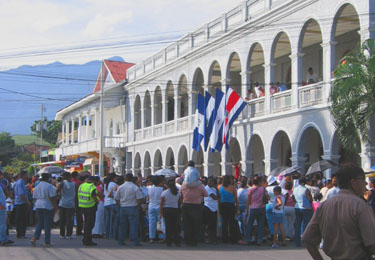
|
|
Go to the next day, page 2: Getting to Roatán. |
|
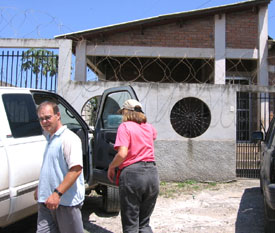 transport bus, Mike, a Baptist missionary, offered us a ride, not only to
the finance office on base, but directly to the bus stop
in the next town over where he lives, Seguatepeque.
transport bus, Mike, a Baptist missionary, offered us a ride, not only to
the finance office on base, but directly to the bus stop
in the next town over where he lives, Seguatepeque.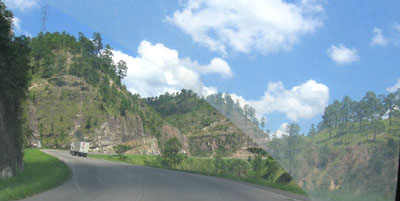 The
winding roads up over the mountains sometimes had two sets of vehicles
passing those slow-moving, overloaded trucks, even where there was no visibility and
double yellow lines.
The
winding roads up over the mountains sometimes had two sets of vehicles
passing those slow-moving, overloaded trucks, even where there was no visibility and
double yellow lines.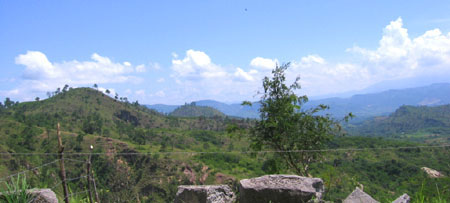 We
also stopped at another house where Mike was supposed to drop off their
mail from the base. They check each other's mail every week or so to
get US postal service. This place also had dogs and razor wire.
We
also stopped at another house where Mike was supposed to drop off their
mail from the base. They check each other's mail every week or so to
get US postal service. This place also had dogs and razor wire.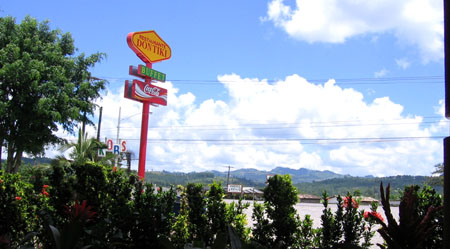 When
we got to Don Tiki's Restaurant, the bus stop, Mike
talked to a woman who was also waiting for the bus and going to La Ceiba
and also to the guard for the restaurant. He looked like an old-time
cowboy with a black hat and a pistol holstered on his hip. (Almost all
businesses have armed guards.) We waited for more than an hour in the
surprisingly cool shade on the front veranda.
When
we got to Don Tiki's Restaurant, the bus stop, Mike
talked to a woman who was also waiting for the bus and going to La Ceiba
and also to the guard for the restaurant. He looked like an old-time
cowboy with a black hat and a pistol holstered on his hip. (Almost all
businesses have armed guards.) We waited for more than an hour in the
surprisingly cool shade on the front veranda.  We sat on a raised
section of the floor at the back of the bus between the
seats. The bus driver drove the same as Mike. It was
easier not to watch. It was a l-o-n-g five hours until the first stop where anyone
got off before we got to sit in the padded seats.
We sat on a raised
section of the floor at the back of the bus between the
seats. The bus driver drove the same as Mike. It was
easier not to watch. It was a l-o-n-g five hours until the first stop where anyone
got off before we got to sit in the padded seats. 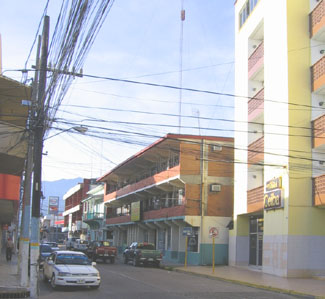 <<
Hotel Iberia is the three-story brick building next to another recommended
hotel, Hotel Ceiba—the
taller yellow building. Accommodations were adequate and reasonably
priced.
<<
Hotel Iberia is the three-story brick building next to another recommended
hotel, Hotel Ceiba—the
taller yellow building. Accommodations were adequate and reasonably
priced. 

